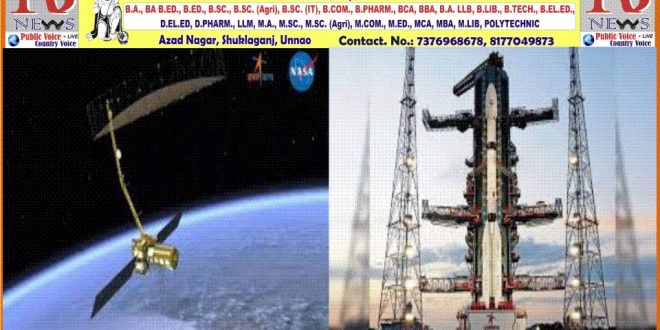The Indian Space Research Organisation (ISRO) on Wednesday launched an earth observation satellite jointly developed by ISRO and NASA. The launch took place at 5:40 pm Indian time. The NISAR satellite is a combination of human skills and a decade-long exchange of software and hardware between the two space agencies, aimed at studying the entire Earth from a sun-synchronous orbit.
 The NISAR (NASA-ISRO Synthetic Aperture Radar) satellite, built as a joint effort of the Indian Space Research Organisation (ISRO) and the US space agency NASA, will be placed in a 747 km sun-synchronous orbit through a GSLV Mk-II rocket. Let’s know why this mission is special and what it will do.
The NISAR (NASA-ISRO Synthetic Aperture Radar) satellite, built as a joint effort of the Indian Space Research Organisation (ISRO) and the US space agency NASA, will be placed in a 747 km sun-synchronous orbit through a GSLV Mk-II rocket. Let’s know why this mission is special and what it will do.
What is NISAR?
NISAR is an earth observation satellite weighing 2,392 kg. It is the first satellite that uses two different frequencies, NASA’s L-band and ISRO’s S-band. This dual radar system will help it observe changes on the earth’s surface with greater accuracy than ever before. According to NASA, both these systems are specialized in measuring different characteristics of the earth’s surface, such as moisture, surface texture and movement. The cost of this satellite is more than $ 1.5 billion (about Rs 12,500 crore), making it one of the most expensive Earth observation satellites in the world.
NISAR took 10 years to build. It has a special 12-meter gold mesh antenna, which is the largest in low Earth orbit. It is connected to ISRO’s I-3K satellite bus, which has systems for command, data, propulsion, and direction control and a 4 kilowatt solar power system.
How will NISAR work?
After launch, NISAR will be placed in a sun-synchronous orbit at an altitude of 747 kilometers, with an inclination of 98.4 degrees. But it will not start taking pictures immediately. The satellite will spend the first 90 days in commissioning or in-orbit checkout (IOC) to prepare it for scientific work. NISAR’s synthetic aperture radar (SAR) will send radar waves to the earth’s surface and measure their return time and phase changes. It will use two types of radar:
L-band SAR (1.257 GHz): This is a long-wave radar that can see dense forests and movement under the soil. It will help measure small changes on the ground.
S-band SAR (3.2 GHz): This is a short-wave radar that will capture surface details, such as crops and water surface.
NISAR will use SweepSAR technology for the first time, which will provide high-resolution data within a radius of 242 kilometers. It will scan the entire earth every 12 days, in all weather conditions, day or night, despite clouds or darkness.
Why is NISAR mission special?
The NISAR mission symbolizes the growing partnership between India and the US in the space sector, which will revolutionize earth monitoring. This mission will study the earth’s ecosystem, ice sheets, vegetation, forests, groundwater, sea level rise, and natural disasters such as earthquakes, tsunamis, volcanoes, and landslides. Its dual radar system and SweepSAR technology enable it to collect accurate data day and night and in all weather conditions, despite clouds, smoke, or dense forests, which makes it different from other satellites. NISAR data will be available free of cost to scientists, farmers, and disaster management teams, especially in a few hours in a disaster-like situation. This data will prove useful not only for India and the US, but the whole world in disaster management, agriculture, and climate monitoring.
What will be the impact of NISAR?
The NISAR mission will help in understanding the changing environment and natural processes of the earth. It will assess risks in earthquake-prone areas like the Himalayas, track volcanic activity, and help in monitoring infrastructure. Its data will help farmers in crop management and scientists in understanding the effects of climate change.
 RB News World Latest News
RB News World Latest News






